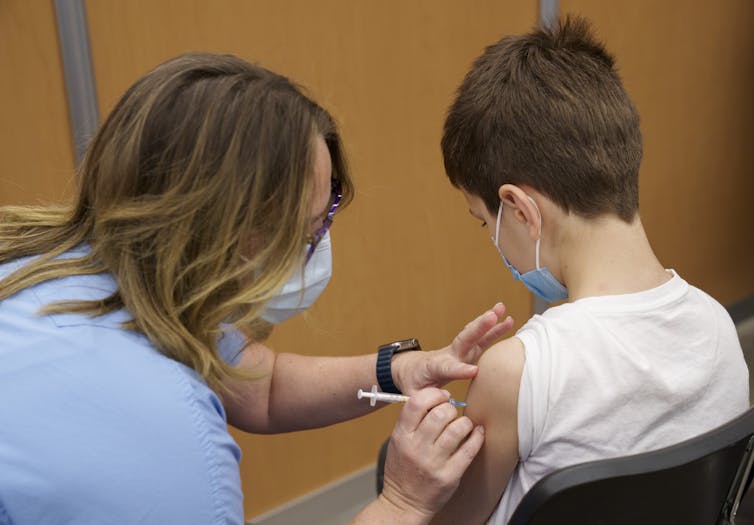My research includes the moral and legal aspects and policy implications of childhood vaccination. COVID-19’s effects on children has an impact on that research. And these effects appear to be changing, making the need for widespread COVID-19 vaccine uptake among children more urgent.
Early in the pandemic, evidence suggested children generally avoided severe COVID-19 infections. That rosier picture is now fading. Emerging research signals that children’s susceptibility to SARS-CoV-2, the virus that causes COVID-19, has increased in “frequency and severity” over the course of the pandemic.
One newly released study of British Columbia’s Lower Mainland chronicles the dramatic rise in infections among those under 19. This surge in childhood infection with the Omicron variant is consistent with estimates in other parts of Canada and beyond.
Increased frequency of infections among children will necessarily yield a greater number of cases with severe outcomes, including hospitalizations and deaths. Children with co-morbidities are especially vulnerable to severe COVID-19 outcomes.
Like adults, children can also suffer from long COVID that can damage their lungs, their brains and create a host of other health problems.
Read more: Do kids get long COVID? And how often? A paediatrician looks at the data
Low vaccination uptake among minors
A multi-pronged approach to restrict transmission, including masking, is advised over any one single preventive measure. This is likely even more important with new variants on the horizon.
Yet vaccination remains one of the best means to protect against severe outcomes when breakthrough infection occurs. Additionally, vaccination may decrease the likelihood of long COVID. The Ontario government recommends vaccination for those under 18.
That’s why it’s alarming that vaccine uptake among minors of the primary series of two doses, particularly for those under 12, remains low.
Compared to the provincial average of 90 per cent for those 12 and above, only 41 per cent of Ontario children aged five to 11 have completed their primary series. Uptake among those under five is almost non-existent, with just six per cent receiving their first doses in the two months since Health Canada approved a COVID-19 vaccine for this cohort. Numbers across the country are roughly similar.
Notably, Ontario declined to add COVID-19 to the list of “designated diseases” in its Immunization of School Pupils Act last fall, despite support for this move by some school boards and both the opposition Liberals and NDP.
It’s time to revisit that decision.
Adding COVID-19 to the act will not make COVID-19 vaccination mandatory for school entry. Whether childhood vaccines should be mandatory is a separate debate. But it may, nonetheless, help address the COVID-19 vaccine uptake among the province’s school-aged children.

Vaccine requirements for school entry
Ontario, New Brunswick and British Columbia are the only Canadian jurisdictions that have vaccination requirements for school entry. But minors aren’t required in any of those provinces to be vaccinated to attend day care, elementary or high school.
British Columbia’s regulation explicitly makes the duty a reporting one only. Ontario requirements are somewhat different, as the parental duty is to “cause the pupil to complete the prescribed program of immunization.” Yet the duty does not apply where the parent “has filed a statement of conscience or religious belief.”
This means a parent can refuse to have their child vaccinated against any or all of the designated diseases by signing and having notarized a government-issued form affirming a “sincere belief.”
In practical terms, this makes the duty a reporting one in Ontario as well. The situation in New Brunswick is virtually the same.
Where Ontario and New Brunswick differ, however, is that Ontario requires that parents seeking a sincere-belief exemption also attend an “education session.” For some, access to this education session is the real benefit of listing COVID-19 among the designated diseases.

Vaccine hesitancy and COVID-19
Vaccine hesitancy is attributed as the cause for low vaccine uptake when it comes to COVID-19. But it’s complicated.
While a small percentage of parents reject all vaccines, many more are selective about vaccines and are generally more cautious about newer ones than older ones. In fact, generally positive parental attitudes about routine childhood vaccines are a poor indicator of their attitudes toward COVID-19 vaccines, both in Canada and elsewhere.
When it came into effect in Ontario in 2017, the requirement to undergo an education session for those seeking a sincere-belief exemption made little difference in attitude because vaccine uptake against the designated diseases, while less than optimal, was still generally high.
And education sessions can be like sermons to that dogged minority whose minds are made up on the topic. Mandatory education can also be counterproductive and cause people to become more entrenched in their opinions.
Read more: Five reasons why young people should get a COVID booster vaccine
However, there is a very large gap between low childhood vaccination rates for COVID-19 and the high rates for routine childhood vaccines.
Not anti-vaxxers
This suggests that most parents who have so far refused COVID-19 shots are not hard-core anti-vaxxers. This may provide an opening to sway more parents to have their children vaccinated.
Research about parental attitudes toward COVID-19 vaccination is fast-moving, and understandably there are large gaps. But the general conclusion is that vaccination campaigns targeted to specific demographics can increase uptake.
It’s unclear whether adding COVID-19 to the list of “designated diseases” in Ontario or elsewhere in Canada would have the desired effect. And certainly the design and content of education sessions matter.
But it defies logic to have a regulatory scheme already in place committed to increasing “the protection of the health of children” and decide that a pandemic is not a good time to use it.
Adding COVID-19 to 'designated diseases' could boost vaccine uptake among children - The Conversation
Read More

No comments:
Post a Comment